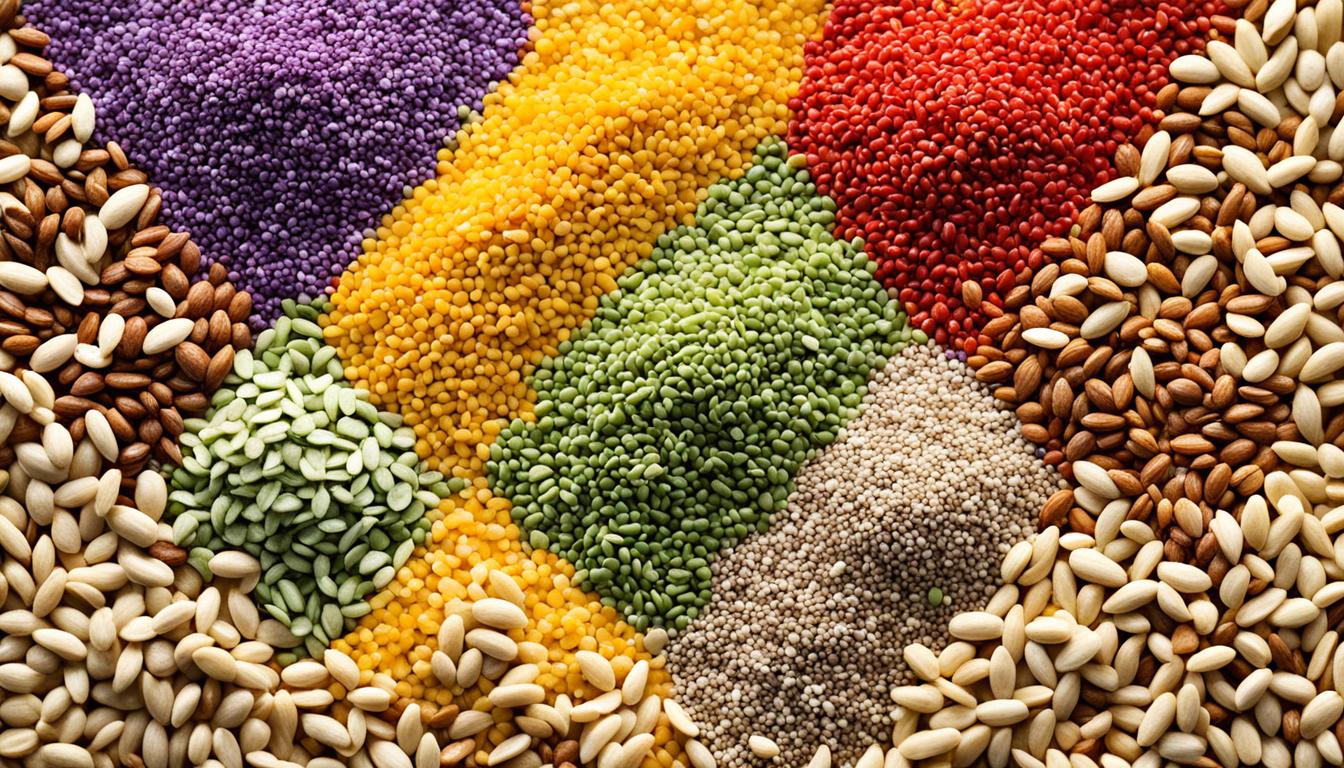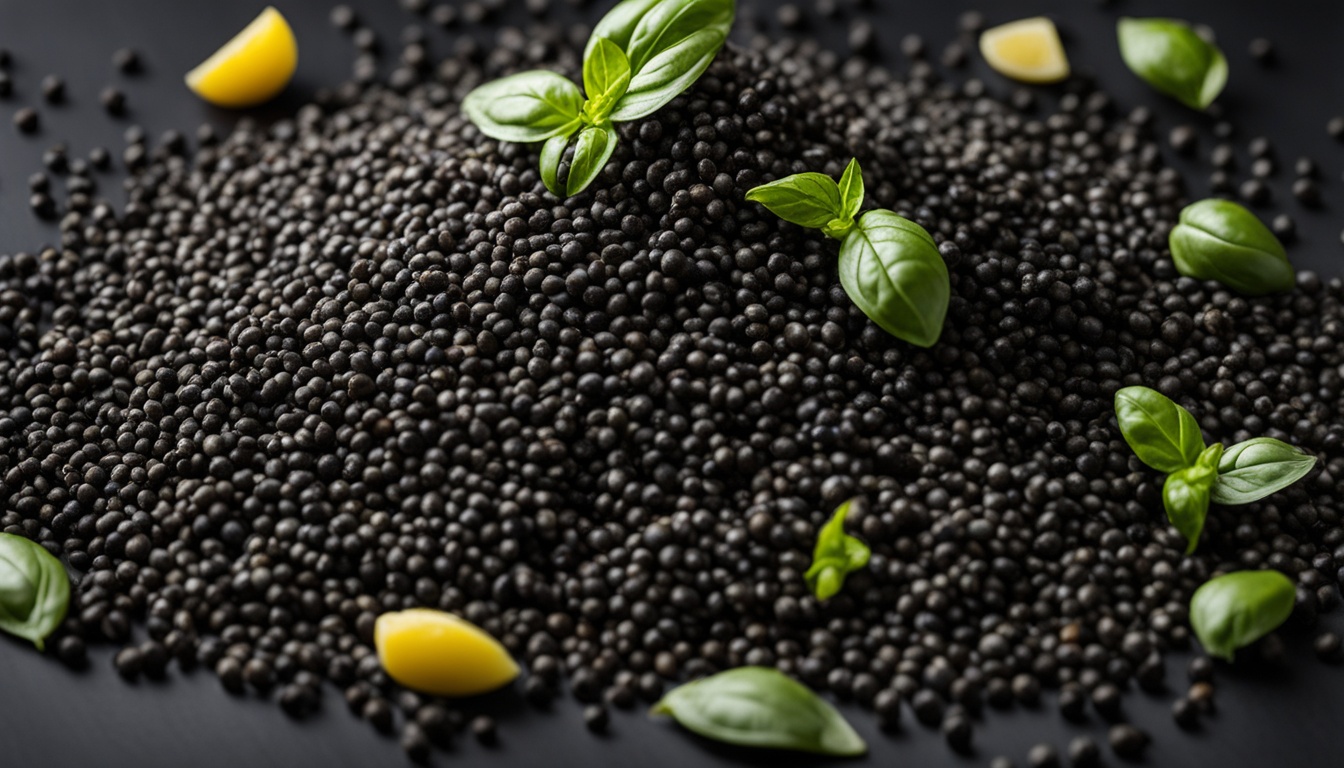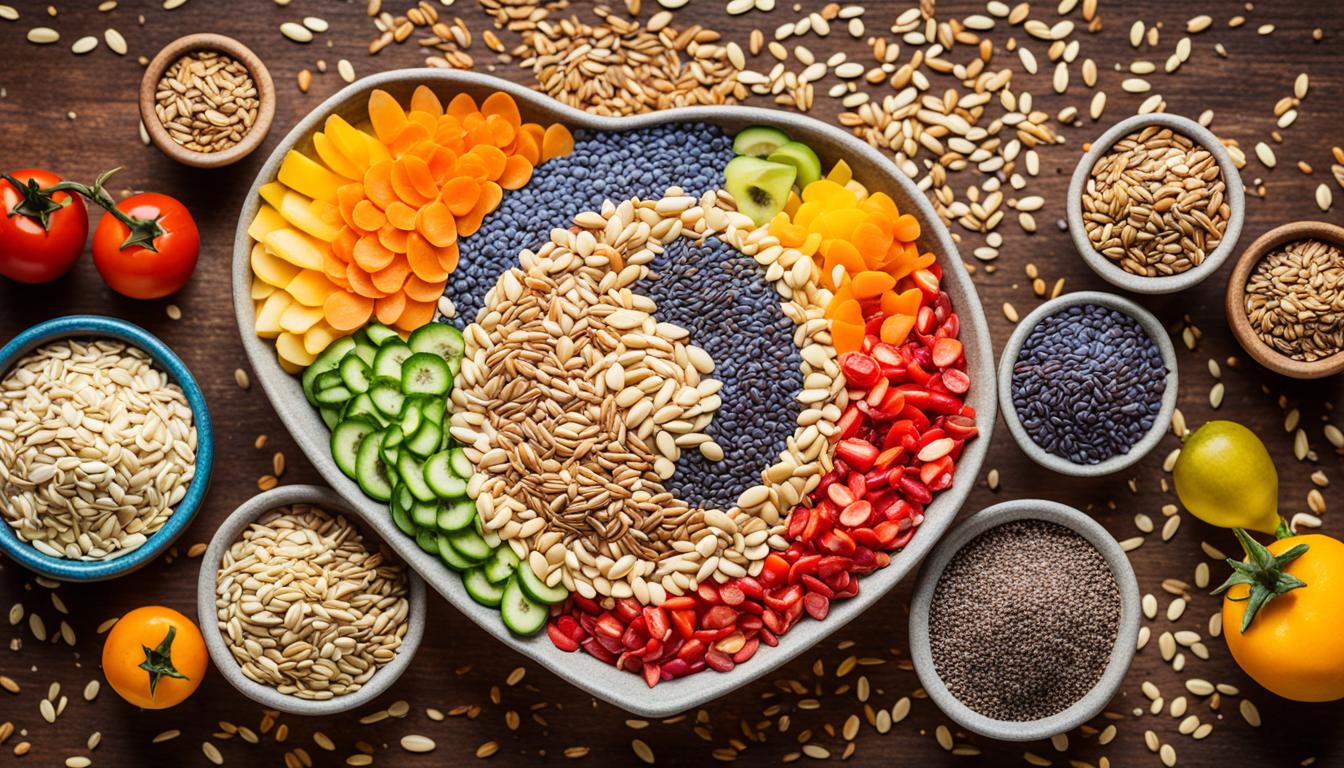One tablespoon of sesame oil contains 124 kilocalories and 14 grams of total fat. It blends both saturated and unsaturated fats well. These small seeds are loved by researchers and chefs for their rich nutrition and flexibility in cooking.
Sesame seeds, also known as Sesamum indicum L., have been in human diets for ages. They are famous for their protein, lipids, antioxidants, and healthy fats. The oil made from these seeds is essential in many kitchens. It’s full of nutrients and has anti-inflammatory effects. For anyone wanting healthier, tastier food, sesame seeds and their oil are a great choice.
Key Takeaways
- Sesame seeds are a nutritional powerhouse, rich in proteins, healthy fats, and antioxidants.
- Sesame seed oil is a versatile cooking ingredient, available in both cold-pressed and toasted varieties.
- Sesame seeds offer anti-inflammatory properties and potential health benefits, making them a valuable addition to the diet.
- Sesame seeds have a long history, originating from East Asia and being used in a variety of cuisines worldwide.
- Sesame farming is an important economic activity in regions like Kenya, with growing interest in its cultivation and market development.
Unleashing the Power of Sesame Seeds
Sesame seeds are a powerhouse of nutrition. They are rich in protein, fiber, and healthy fats. They also contain vitamins and minerals. These seeds help keep our hearts healthy and support good cholesterol levels. They boast antioxidants like lignans and polyphenols, offering many health benefits.
Health Benefits of Sesame Seeds
Eating sesame seeds has many health advantages. The antioxidants in them fight oxidative stress, reducing inflammation. This makes them good for people with inflammatory issues. Sesame seeds also contain anti-inflammatory compounds, like sesamol and sesamin. They are also rich in vitamin E and K1, which help as antioxidants and with blood clotting.
Versatility in Cuisine: From Baking to Sauces
Sesame seeds add a delicious flavor and texture to many foods. They’re great in baking, giving a nutty taste to breads and cookies. In Asian cooking, they’re used in sushi and stir-fries. They’re also perfect as a topping on noodles. Plus, you can make tahini from them, a key part of dishes like hummus.
Understanding sesame seeds
Sesame seeds have an amazing history, originating in East Asia. They are highly valued in traditional Chinese medicine. These tiny, oval seeds come from the Sesamum indicum plant. They’ve been grown for thousands of years for their great taste and health benefits. Since 3500 BCE, they have been a key part of many diets.
Varieties of Sesame Seeds
Sesame seeds are available in white, brown, and black colors. In Kenya, you’ll usually find brown and black sesame seeds. However, now they also grow white sesame seeds. Every type has its own flavor. Black sesame seeds, for example, taste earthier than the lighter ones. These varieties add unique tastes and looks to meals.
Cultivating Sesame: From Farm to Table
Sesame farming is growing fast in Kenya. It thrives in many climates, mainly in Eastern, Coast, and Rift Valley regions. Lamu is a key spot for sesame. Farmers there find growing sesame appealing due to its economic benefits and the chance for a better life. Sesame plants are tall and beautiful, with flowers like trumpets. They can grow up to 6 feet high. Look closely, and you’ll see clusters of seed pods. These pods are full of the valuable sesame seeds.
Sesame Farming in Different Regions
Sesame seed pods burst open when the seeds are ripe. The seeds are oval and can be white, brown, or black. In Kenya, most farmers choose brown or black seeds. White seeds are also being tried out. The farmers in Lamu love growing sesame. They see it as a way to improve their lives.
Growth and Harvesting Processes
| Planting Depth | Sesame seeds need to be planted shallow, about 1-2 centimeters. This is done in well-prepared soil. |
|---|---|
| Harvesting Techniques | On small farms, people pick sesame seeds by hand. Bigger farms use machines to do this job quickly. |
| Irrigation Methods | For organic farms, drip irrigation is common. This approach saves water. It also keeps the soil moist. |
| Weed Management | Organic techniques like mechanical weeding and using cover crops help control weeds. They make the soil better, too. |
| Packaging | After grading, sesame seeds are packed in eco-friendly material. This keeps them fresh and clean. |
Nutritional Profile of Sesame Seeds
Sesame seeds are full of key nutrients that boost your diet. They’re top-notch protein sources with a great amino acid mix. Plus, these seeds have lots of fiber to aid digestion and keep your gut happy. They also pack healthy fats like those in nuts, which are good for your heart.
Protein and Fiber Content
In just three tablespoons of sesame seeds, you get 5 grams of protein. That’s a solid amount. They also offer 3.5 grams of fiber in the same serving. This mix of protein and fiber packs a healthy punch in any meal.
Essential Vitamins and Minerals
Sesame seeds are loaded with vital vitamins and minerals like calcium and zinc. These nutrients are crucial for your bones, blood, and energy. They even have vitamin B6 and vitamin E, which are powerful antioxidants.
Healthy Fats and Antioxidants
Besides their staple nutrients, sesame seeds are full of good fats and antioxidants. These include healthy unsaturated fats and compounds that help fight diseases. Lignans, polyphenols, and phytosterols in sesame seeds target oxidative stress and lower inflammation.
Culinary Uses of Sesame Seeds
Sesame seeds are used in many foods to add a special flavor and texture. They’re often sprinkled on breads, pastries, and cakes for a nice crunch. You also find them in pies’ crusts or mixed in granola and energy bars. This adds taste and makes the food more nutritious.
Asian Cuisine: Sushi, Stir-fries, and More
In Asian cooking, sesame seeds play a big role. They top sushi rolls for a nutty taste and look. In stir-fries, they bring crunch and flavor. They’re even used to make a paste for desserts like glutinous rice balls and mooncakes.
Seasoning and Garnishing
Sesame seeds can make dishes more exciting as a garnish. They’re great on salads, veggies, and rice, adding flavor and a nice look. These seeds are also the base for tahini, found in hummus and dips. You can even add them to drinks and smoothies for extra flavor and nutrition.
| Sesame Seed Variety | Culinary Characteristics |
|---|---|
| White Sesame Seeds | The most prevalent variety, used as a finishing touch for dishes or sprinkled atop salads. |
| Black Sesame Seeds | Offer an intensified flavor that is great for stir-fries, baked goods, and sauces. |
| Toasted Sesame Seeds | Made from black or white sesame seeds, they add a new level of nutty essence to dishes. |
| Hulled Sesame Seeds | With the outer husk removed, they offer a distinct taste and richer flavor as they retain more natural oil. |
sesame seeds and Inflammation
Sesame seeds are more than just tasty. They have big anti-inflammatory benefits. Studies show that compounds in sesame seeds, like sesamol and sesamin, can lower inflammation. This was seen in both animal and cell studies, showing their potential help for inflammatory diseases. The unique plant chemicals and antioxidants in sesame are why they can fight inflammation.
Anti-inflammatory Properties
Sesame seeds are strong against inflammation. Research shows that sesamol and sesamin in them cut down on inflammatory markers like C-reactive protein. This was shown not just in animals but also in human cell tests, hinting that eating sesame seeds might help with inflammation.
Potential Health Benefits
Sesame seeds bring more than anti-inflammatory help. They are high in fiber, which is good for digestion and gut health. The unsaturated fats in them improve heart health, lower cholesterol, and help blood clot properly. Plus, the zinc and vitamin E in sesame seeds boost skin health, help with hair growth, and they’re great for collagen. Adding sesame seeds to your diet is an easy way to be healthier overall.
Sesame Seed Oil: A Versatile Powerhouse
Sesame seed oil is packed with nutrition and comes from small . You can get it in two main forms: cold-pressed and toasted. The cold-pressed kind keeps more of the seed’s natural goodness, perfect for healthy cooking. Then, there’s the toasted version, great for adding a nutty taste to your food or finishing off dishes.
Cooking with Sesame Seed Oil
is very useful in the kitchen. For recipes that need mild cooking, cold-pressed sesame oil is a good fit. It keeps its nutrients and adds a subtle taste.
But if you want to top off your dishes with a flavorful punch, try toasted sesame oil. It’s often used at the end of cooking to boost the dish’s aroma and flavor. This makes a handy cooking tool, enhancing both the nutrition and taste of many meals.
Cosmetic and Medicinal Uses
Besides cooking, is also great for your health and beauty. High in antioxidants and good fats, it’s ideal for skin and hair care. It can moisturize the skin, help make collagen, and keep hair healthy.
People have been using for centuries to help with various health issues. That’s because it has things in it that fight inflammation and offer other health benefits.
Incorporating Sesame Seeds into Your Diet
Sesame seeds are easy to add to your meals and snacks in many ways. It’s crucial to keep them fresh by storing them correctly.
Unopened sesame seed oil stays good for about two years in a cool, dark spot. Once opened, use it within six to nine months for the best taste.
For whole seeds, store them in an airtight container in a cool, dry place. This keeps their flavor and nutrients intact.
Tips for Storing Sesame Seeds
Proper storage is essential for the goodness of sesame seeds. Unopened sesame oil can keep for two years when it’s cool and dark.
After opening, use the oil within six to nine months to enjoy its full taste and nutrition. For whole seeds, keep them in an airtight container in a cool, dry place.
Recipes and Creative Ways to Use Sesame Seeds
Sesame seeds add a fun twist to various dishes. Besides using them on salads and rice, try them in baking.
Ground up, sesame seeds make tahini, perfect for hummus and more. You can also blend them into drinks for a nutrition boost.
With their unique taste and health perks, sesame seeds are a great kitchen staple.
Conclusion
Sesame seeds are amazing. They come from East Asia but are loved worldwide now. They are full of good stuff like key nutrients, good fats, and antioxidants. Adding sesame seeds or oil to your meals will make them tastier and healthier.
You can use sesame seeds in many ways. Sprinkle them on sweets or in Asian meals. They are also known for fighting inflammation. So, they are a must-have in your kitchen. Sesame seeds can make many foods better, like hummus or sweets. They add a special crunch and nutty flavor.
Start using sesame seeds today. You can add them to almost any meal. They are great for taste and health. Enjoy trying new dishes with these little seeds. They bring a lot to the table.
FAQ
What are the health benefits of sesame seeds?
How can sesame seeds be used in cooking and baking?
What are the different varieties of sesame seeds?
How are sesame seeds cultivated and harvested?
What is the nutritional profile of sesame seeds?
How can sesame seed oil be used?
How can I incorporate sesame seeds into my diet?
Source Links
- https://www.ncbi.nlm.nih.gov/pmc/articles/PMC11049391/
- https://aloha.com/a/guide/category/aloha-ingredients-c-HHKt/sesame-seed-oil-and-health-what-you-need-to-know-q-Rn6VYL
- https://globaleat.net/healing-foods/sesame-seeds-the-healing-power/
- https://www.ispiceyou.com/products/sesame-seeds-black
- https://www.healthline.com/nutrition/sesame-seeds
- https://hlagro.com/blog/the-journey-of-sesame-from-farm-to-plate/
- https://permacultureplants.com/plants/sesame/
- https://www.yashindustriesgroup.com/blog/journey-of-organic-sesame-seeds
- https://www.ncbi.nlm.nih.gov/pmc/articles/PMC9573514/
- https://www.scmp.com/cooking/article/3089729/sesame-seeds-and-how-use-them-your-cooking-chefs-tip
- https://www.mccormick.com/articles/mccormick/about-sesame-seeds
- https://www.ncbi.nlm.nih.gov/pmc/articles/PMC8575626/
- https://www.wellyme.org/post/sesame-oil-and-sesame-seeds
- https://kodgav.co.uk/en-gb/blog/5-delicious-ways-to-eat-sesame-seeds
- https://www.medicalnewstoday.com/articles/sesame-seeds-benefits-risks-meal-ideas-and-more




